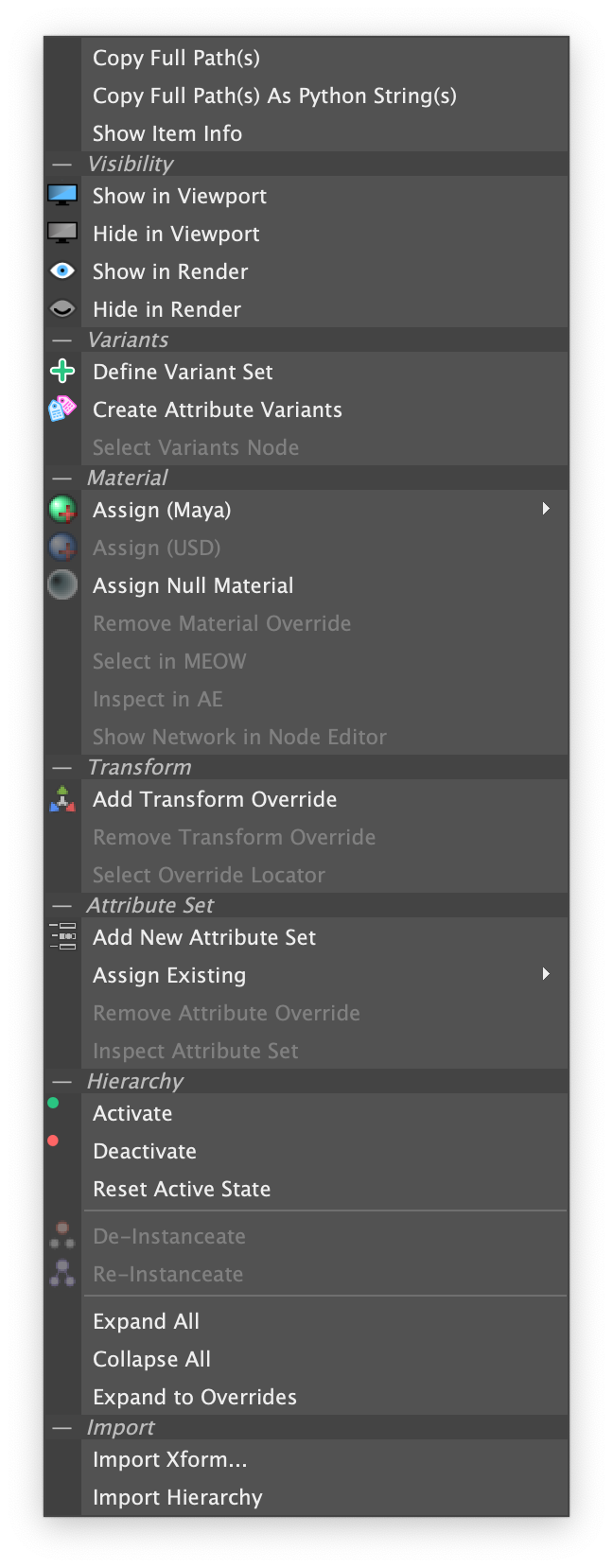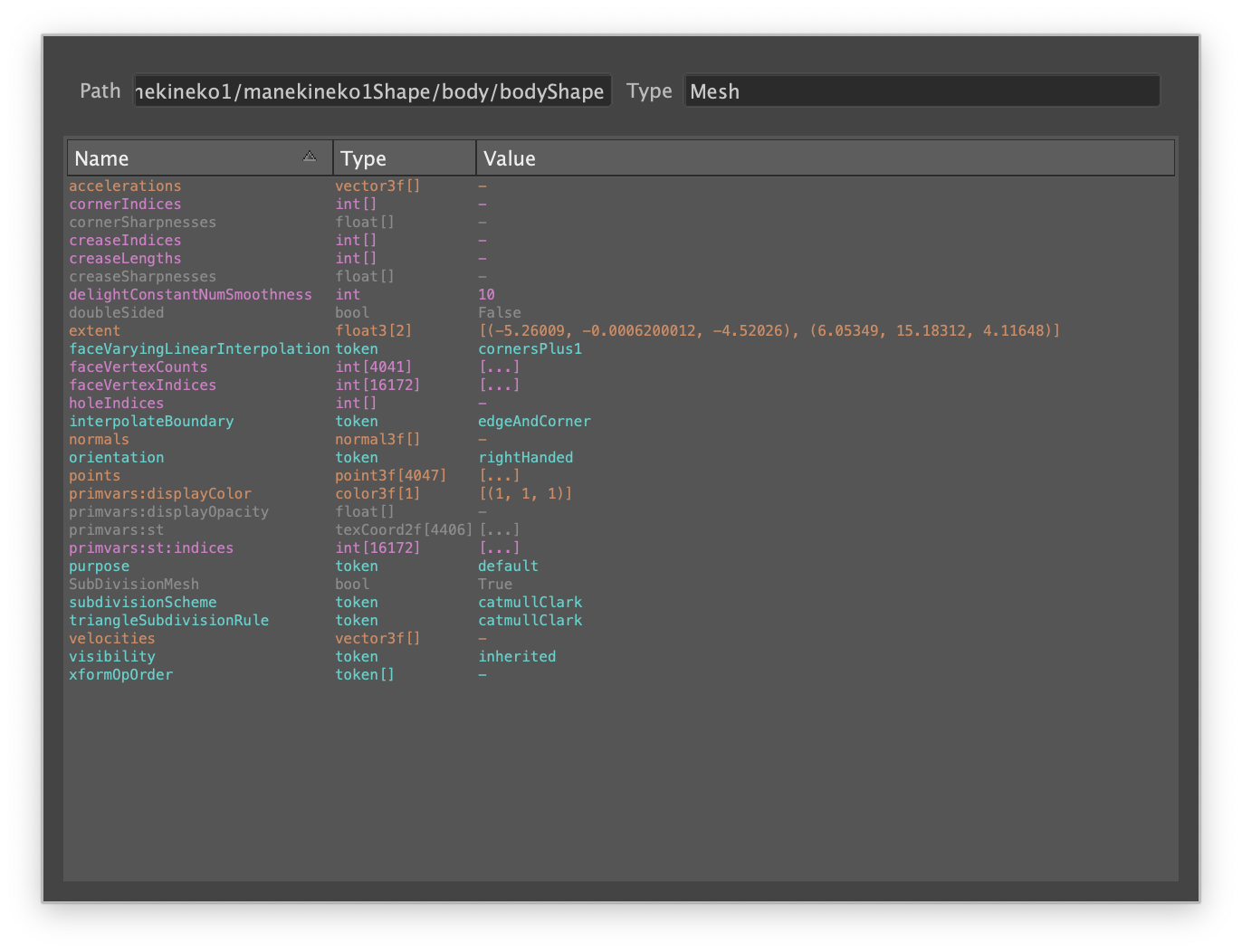# MEOW
The MEOW, short for "Multiverse Explore & Override Window",is designed to explore the entire hierarchy for the selected Multiverse Compound (displayed on top in blue), and override any of its items, selectively.
Once an override is set, it is inherited by children items in the hierarchy except if further overridden at a child location. Overrides are performed in the MEOW via RMB actions.
You can also MMB on an Item to see the properties, types and values of the data at that item location.
Click the help “?” to see the meaning of colors and icons.
Note
The MEOW UI has been designed with performance in mind and can fully expand extremely complex hierarchies.
# Selection
You can select single or multiple items via LMB and shift+LMB. Any selection performed in MEOW will be in-sync with the Viewport where selected items will be highlighted in yellow. Likewise when selecting items in the viewport, the selection will be also in-sync in the MEOW.
# Inheritance
Overrides that set on an item are inherited by children items automatically this means if you assign an override on the topmost node in the hierarchy, all its children items will inherit the same override.
# Maya Vs Written Overrides
Overrides can be either saved in the Maya scene or written as USD overrides:
- Any overrides that is set in MEOW and not written as override will be saved when a Maya scene is saved.
- Overrides can be written with a Multiverse Write USD Override operation to a USD file. USD overrides can be then “layered” in the same Multiverse Compound. An option exist so that once you save an override for a Compound, it will be automatically “synced” and layered on the topmost later of its relative compound.
Viewport Visibility Override
In MEOW you can also set viewport visibility (VV), however this special
setting cannot be saved as a override since this concept does not really exist
in USD.
Authoring Attribute Variants in MEOW
In MEOW you can also author Attribute Variants and define their VariantSets, however the result of such authoring can be only visible once you have written the override. You can do so quickly with the sync option active in the Write USD Override UI.
# Main UI Reference

| Column | Meaning | |
|---|---|---|
| Item Name | A text string | This is the name of the item (primitive), there are various types of primitives (and icons), the most common being shapes and transforms whose icons you should be familiar to. The icon can be superimposed with colored circles representing the activity state and the purpose, see the help window for more details. |
| VV Viewport Visibility | Eye Open | Visible in viewport (note that this is _not_ an override since in USD there is only one type of visibility: Multiverse offers the decoupling of display and rendering visibility just like you maybe used in Houdini). |
| Eye Outlined | Hidden in viewport. | |
| RV Rendering Visibility | Display On | Visible when rendering. |
| Display Off | Hidden when rendering. | |
| RV Rendering Visibility | Display On | Visible when rendering. |
| Xfrm Affine transform | Axis Triad | Create / select a transform (locator) node. This is injected in the correct point of the hierarchy, respecting its "foster parent". It overrides transformations with full support for animation as well. |
| Mat Material (Shading Group) Assignment | Grey | Use the material assignment information (material <--> primitive) as specified within the USD file. To resolve, the material to assign must exist in Maya. This overrides the DAG material assignment on the Compound Shape node. |
| Green | Use the material assignment information (material <---> primitive) specified in MEOW. To resolve, the assigned material must exist in Maya. This overrides the material assignment written in the USD file. | |
| Blue | Use the material assignment information (material <---> primitive) specified in MEOW. To resolve, the assigned material must exist in USD. This overrides the material assignment written in the USD file. | |
| Xray | A "Null Material" assignment in MEOW: this effectively acts as an override that removes a material assignment written in USD. | |
| Attr Attribute Assignment | Attribute list |
Creates / select a mvSet node and use it to assigning a
namespace and rendering attribute for each renderer. An
mvSet can contain a Maya set node (used by
Arnold / Renderman / Vray ), a dlSet node used by
3Delight, a vrayObjectAttributes node and other set-like
nodes used by Vray, and a redshiftMeshParameters and
other set-like nodes used by Redshift. |
| Variants | Compounded icon | This column shows a "compounded icon" with three areas: the left side, the top right and the bottom right. These three areas encode all the information for the presence and selection of a variant for this item. |
| Left side: Existing Default Variant | Display if a default variant is present, and use it. | |
| Left side: Existing Selected Variant | Select / use a non—default variant. | |
| Left side: Existing Default + Newly Added Variant | Shows that a new variant has been added aside the default one. | |
| Left side: Existing Selected + Newly Added Variant | Shows that a new variant has been added and was selected. | |
| Left side: None Existing + Newly Added Variant | Shows that a new variant has been added and there is no default variant. | |
| Top-right: Existing Hierarchy Variant | Shows that a new hierarchy variant exists. | |
| Bottom-right: Existing Added Variant | Shows that a new hierarchy variant was added. | |
| Bottom-right: Newly Added Attribute Variant | Shows that a new attribute variant was added. | |
| Bottom-right: Existing and Newly Added Attribute Variant | Shows that a new attribute variant was added besides an existing one. |
# RMB UI Reference
RMB-click will pop up the following UI:

This will provide access to all the following functionalities:
- Attribute Variants authoring
- Material Overrides
- Transform Overrides
- Attribute Overrides
- Active State Overrides
- De-instance Override
- Importing USD as Maya data
- Several utility and navigation functions
# MMB UI Reference
RMB-click will pop up the "item info" UI so you can inspect any property that exist on that specific USD item:

# Help "? UI Reference
Click on the "?" icon will pop up the "help info" UI so you can understand the meaning of the various icons and text colors used in MEOW. exist on that specific USD item:

